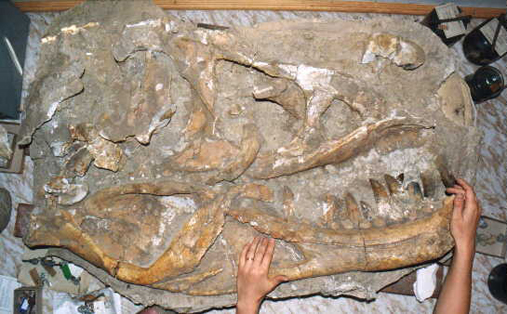A cooperation between the Paleontological Museum, University of Oslo, Norway and Institute of Paleobiology, Polish Academy of Sciences, Warsaw, Poland.
Introduction
During a postdoctoral research project entitled "Jaw mechanism in carnivorous dinosaurs function and variation of the intramandibular joint of theropods" Jørn H. Hurums main interest was with the tyrannosaurids. In the autumn of 1998, a nearly complete lower jaw of Tarbosaurus was prepared by a team consisting of Bjørn Lund, Hans Arne Nakrem, Øyvind Enger and Jørn H. Hurum from the Paleontological Museum, Oslo with help from Tomasz Sulej of the Institute of Paleobiology, Polish Academy of Sciences, Warsaw.
The preparation of the lower jaw was complicated because it was preserved together with the left side of the skull. The lower jaw was disarticulated from the skull and its constituent bones were separated. Silicone moulds of these were made during the 14 days spent in Poland after which Prof. Halszka Osmólska suggested the skull should be prepared in Oslo. This was a big challenge which we accepted without hesitation. For the past 8 years, Hurum had been working with specimens of small multituberculate mammal specimens from the Polish-Mongolian Expeditions. The change from the smallest vertebrates of the Gobi Desert to one of the largest, was a challenge in preparation techniques and logistics. A multituberculate has a skull size between 20 and 30 millimetres and the Tarbosaurus specimen has a skull length of 1,2 meters.
Tarbosaurus bataar
Tarbosaurus is a close relative of Tyrannosaurus rex and they were of similar size. While Tarbosaurus roamed in Mongolia, Tyrannosaurus was the king of the late Cretaceous in North America.
The specimen of Tarbosaurus prepared in Norway has the catalogue number ZPAL MgD-I/4. It was found in Nemegt, Gobi Desert, Mongolia by the Polish-Mongolian Expeditions led by Prof. Zofia Kielan-Jaworowska in 1965. The specimen was partly eroded and only the left leg, the hip and 13 vertebrae were collected. The remaining parts of the skeleton were collected in 1970. The right side of the skull is eroded away, and a few of the internal skull bones are missing.

Fig. 1. The skull still in a wooden crate before the removal of the lower jaw (photo: Jaroslaw Stolarski).
For us, the erosion of the skull was fortunate. Had it been a complete specimens, we would have never be allowed to prepare it as we did. Usually such a valuable specimen is only prepared from the outside. As it was, we took the skull apart bone by bone to reveal many new structures and this specimen is the first Tarbosaurus that can be studied both from the inside and outside. The tools we used.
Problems we want to solve during the study of this specimen:
- Some scientists believe that Tarbosaurus bataar and Tyrannosaurus rex are so much alike that the former belongs to Tyrannosaurus Only a detailed comparison of the two can solve this problem.
- Most scientists claim that the skull and lower jaw of tyrannosaurids were as loosely articulated as in varanoids and snakes today. This means that the flexibility allowed lateral flexion for increasing gape, or maybe it functioned to absorb, or soften, impact during biting.
- Some scientists claim that the robustness of the skull and lower jaws gave a rigid crushing bite.
We hope to solve these questions when the descriptions and comparisons are completed in 2001.
Publications from the project:
Hurum, J. H. & Currie, P. J. (in press): The crushing bite in tyrannosaurids. Journal of Vertebrate Paleontology. 10 pp. 2 figures. [Describes the lower jaw in Tarbosaurus and Tyrannosaurus].
Sabath, K. & Hurum, J. H. (manuscript): The skull of Tarbosaurus bataar. Acta Paleontologica Polonica (2001).
The preparation
The lower jaw was prepared in Poland in October 1998 and the skull was prepared in Norway in May 1999. A daily Internet diary documented the preparation of the skull while the remaining work was recorded more sporadically. This site was made for a Norwegian audience in 1999, and translated to English in April 2000.
Daily reports during the preparation, May 1999
| May 3 | May 4 | May 5 | May 6 |
| May 7 | May 8 | May 10 | May 11 |
| May 12 | May 13 | May 14 | May 18 |
| Reports on the work with the specimen since the preparation |
Links
About the Russian specimens of Tarbosaurus http://www.mathematical.com/dinotarbosaur.html
About the Tyrannosaurus "Sue" https://www.fieldmuseum.org/happening/exhibits/sue-t-rex
